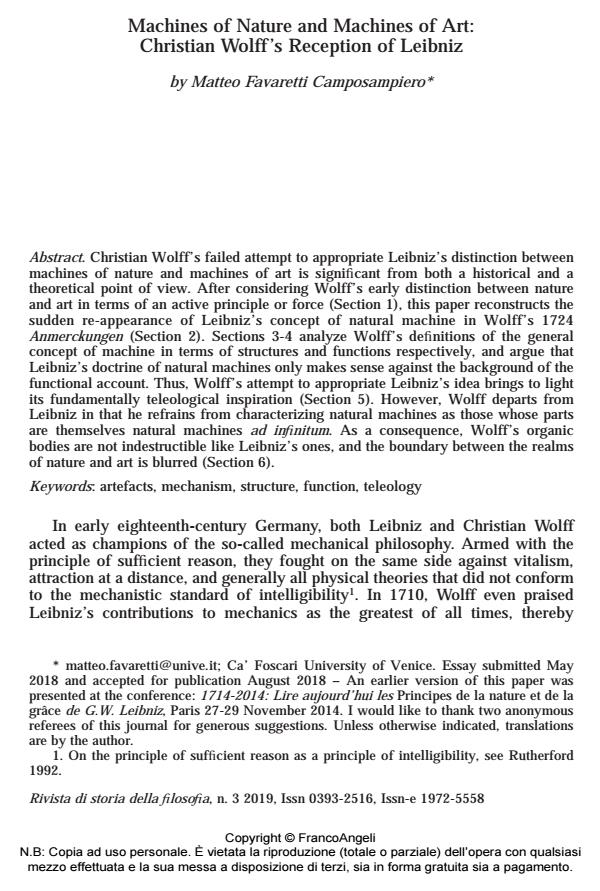Machines of Nature and Machines of Art: Christian Wolff’s Reception of Leibniz
Journal title RIVISTA DI STORIA DELLA FILOSOFIA
Author/s Matteo Favaretti Camposampiero
Publishing Year 2019 Issue 2019/3
Language English Pages 22 P. 431-452 File size 80 KB
DOI 10.3280/SF2019-003002
DOI is like a bar code for intellectual property: to have more infomation
click here
Below, you can see the article first page
If you want to buy this article in PDF format, you can do it, following the instructions to buy download credits

FrancoAngeli is member of Publishers International Linking Association, Inc (PILA), a not-for-profit association which run the CrossRef service enabling links to and from online scholarly content.
Christian Wolff’s failed attempt to appropriate Leibniz’s distinction between machines of nature and machines of art is significant from both a historical and a theoretical point of view. After considering Wolff’s early distinction between nature and art in terms of an active principle or force (Section 1), this paper reconstructs the sudden re-appearance of Leibniz’s concept of natural machine in Wolff’s 1724 Anmerckungen (Section 2). Sections 3-4 analyze Wolff’s definitions of the general concept of machine in terms of structures and functions respectively, and argue that Leibniz’s doctrine of natural machines only makes sense against the background of the functional account. Thus, Wolff’s attempt to appropriate Leibniz’s idea brings to light its fundamentally teleological inspiration (Section 5). However, Wolff departs from Leibniz in that he refrains from characterizing natural machines as those whose parts are themselves natural machines ad infinitum. As a consequence, Wolff’s organic bodies are not indestructible like Leibniz’s ones, and the boundary between the realms of nature and art is blurred (Section 6).
Keywords: Artefacts, mechanism, structure, function, teleology
- Immortal animals, subtle bodies, or separated souls: the afterlife in Leibniz, Wolff, and their followers Matteo Favaretti Camposampiero, in Intellectual History Review /2023 pp.651
DOI: 10.1080/17496977.2022.2116199 - Vegetative Powers Matteo Favaretti Camposampiero, pp.419 (ISBN:978-3-030-69708-2)
- Mechanism, Life and Mind in Modern Natural Philosophy Matteo Favaretti Camposampiero, pp.279 (ISBN:978-3-031-07035-8)
- Galen and the Early Moderns Matteo Favaretti Camposampiero, pp.155 (ISBN:978-3-030-86307-4)
Matteo Favaretti Camposampiero, Machines of Nature and Machines of Art: Christian Wolff’s Reception of Leibniz in "RIVISTA DI STORIA DELLA FILOSOFIA" 3/2019, pp 431-452, DOI: 10.3280/SF2019-003002